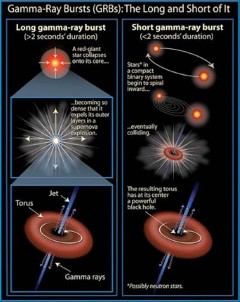Types of gamma-ray bursts (GRBs): This graphic illustrates the different sources and processes that result in long and short gamma-ray bursts. The left panel shows the collapse of a giant star that is thought to lead to a long GRB. The right panel shows the inspiral and coalescence of two neutron stars, which is thought to result in a short GRB.
Credit: NASA
It turns out there are many sources of cosmic gamma rays. Supernovae definitely make gamma rays. Black holes and neutron stars can make a lot of gamma rays. Another source is active galaxies that have a black hole at the center. And pulsars, spinning neutron stars, lead to the generation of pulsed gamma rays. But the most powerful gamma-ray source is the gamma-ray burst (GRB). These happen several times a day across the Universe. They produce brief, intense, flashes of gamma radiation for a few seconds that completely overwhelm every other gamma-ray source in the sky, including the Sun. A gamma-ray burst is so powerful that in a matter of seconds it releases energy equal to all of the Sun's energy generated over its 10 billion year lifetime.
Gamma-ray bursts come in two types – long and short. The physics are different depending on the system from which they originate. Theories exist for the causes of each class of events, but observational support for these models is presently more secure for long bursts. The leading model for short GRBs is a violent collision between two neutron stars that have been circling each other for millions of years. These stars aren't gassy, wispy giants like other stars. A neutron star is more like an atomic nucleus that's 12 km across. In contrast to these merging compact binary stars, long-duration GRBs derive their energy from a supernova, the life-ending collapse and explosion of a single star.
Crashing Neutron stars can make gamma-ray burst jets: These images show the merger of two neutron stars recently simulated using a new supercomputer model. Redder colors indicate lower matter densities. Green and white ribbons and lines represent magnetic fields. The orbiting neutron stars rapidly lose energy by emitting gravitational waves and merge after about three orbits, or in less than 8 milliseconds. The merger amplifies and scrambles the merged magnetic field. A black hole forms and the magnetic field becomes more organized, eventually producing structures capable of supporting the jets that power short gamma-ray bursts.
Credit: NASA/AEI/ZIB/M. Koppitz and L. Rezzolla



